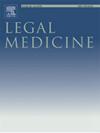Forensic age progression application in a morphological study of an Italian family: A case report
IF 1.4
4区 医学
Q3 MEDICINE, LEGAL
引用次数: 0
Abstract
Processing a photo aimed at the aging of the person depicted is a delicate process. The technique performed in these cases, i.e. age progression, takes into consideration the physiognomic elements of the face and its variations over time.
This study aims to deepen knowledge regarding the morphological similarities of the physiognomic traits found in two generations of an Italian family. Age progression is carried out on the two daughters to compare the result with their current appearance.
Twelve photos were studied, depicting the members of an Italian family in close-up. Three photos of each member of the family were analysed, consisting of the father, mother, and two sisters (L. and E.). Facial features, such as shape of the face, eyes, eyebrows, nose and mouth were evaluated at age 1, 7 and 30. In addition, age progression technique was applied.
Through the analysis of the images, facial features are studied to find similarities, and the problems encountered in studying the photos are discussed. Furthermore, the age progressions are obtained, and they do not show 100% accuracy. This study represents an analysis of age progression technique and explains how the provision of photographic documentation of family members can be important.
法医年龄进展在意大利家庭形态学研究中的应用:一个案例报告
处理一张以人物衰老为目标的照片是一个微妙的过程。在这些情况下进行的技术,即年龄进展,考虑到面部的面相元素及其随时间的变化。本研究旨在加深对一个意大利家庭两代人面相特征的形态学相似性的认识。对两个女儿进行年龄递进,将结果与她们目前的外表进行比较。研究人员研究了12张照片,描绘了一个意大利家庭成员的特写镜头。每个家庭成员的三张照片被分析,包括父亲、母亲和两个姐妹(l和e)。面部特征,如脸型、眼睛、眉毛、鼻子和嘴在1岁、7岁和30岁时被评估。此外,还采用了年龄递进技术。通过对图像的分析,对人脸特征进行研究,寻找相似点,并对研究过程中遇到的问题进行讨论。此外,还得到了年龄的进展,但并非100%准确。这项研究代表了年龄增长技术的分析,并解释了提供家庭成员的照片文件是如何重要的。
本文章由计算机程序翻译,如有差异,请以英文原文为准。
求助全文
约1分钟内获得全文
求助全文
来源期刊

Legal Medicine
Nursing-Issues, Ethics and Legal Aspects
CiteScore
2.80
自引率
6.70%
发文量
119
审稿时长
7.9 weeks
期刊介绍:
Legal Medicine provides an international forum for the publication of original articles, reviews and correspondence on subjects that cover practical and theoretical areas of interest relating to the wide range of legal medicine.
Subjects covered include forensic pathology, toxicology, odontology, anthropology, criminalistics, immunochemistry, hemogenetics and forensic aspects of biological science with emphasis on DNA analysis and molecular biology. Submissions dealing with medicolegal problems such as malpractice, insurance, child abuse or ethics in medical practice are also acceptable.
 求助内容:
求助内容: 应助结果提醒方式:
应助结果提醒方式:


